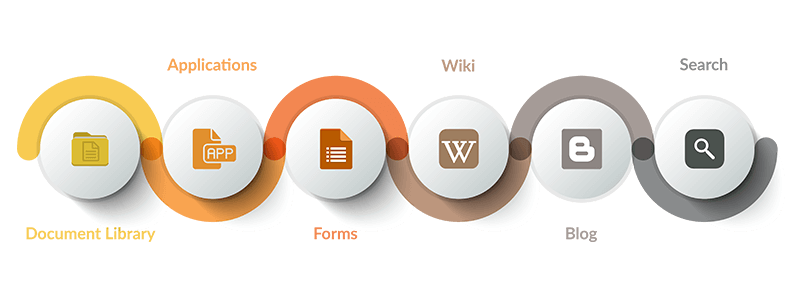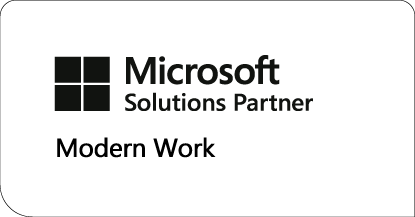SharePoint Solutions
SharePoint Solutions From A Microsoft Gold Partner With

Contact Now 👋
SharePoint Solutions
SharePoint has remained the industry-leading platform for building Collaboration Solutions for the last several years. Iskcon Infotech helps you build solutions with Microsoft Office SharePoint Server/ SharePoint Foundation for – Collaboration, Intranet/ Extranet Portals, Business Processes, Enterprise Content Management, and Search.
With over a decade of experience with SharePoint technology and servicing customers across different geographies – Iskcon Infotech provides solutions over platforms covering – SharePoint Server, Foundation, Office 365, and WSS. Iskcon Infotech’s Services and Solutions over SharePoint include:
- Enterprise Integration with
- Dynamics 365
- D365 NAV/CRM
- Mobile app
- Asset Tracking
- Data Consolidation through diverse sources
- Custom Applications and Workflow
- Migration of existing systems to SharePoint platform
- Document management with electronic/digital signature
Connect, Extend, and Build on SharePoint
In the form of Extranets and Intranets, portals provide users with a single place for accessing information. The source of this can come from a variety of areas – within and outside the organization. SharePoint offers several ways to facilitate corporate communication – some of them provided by web-based components called – Web parts. These include:
Social Networking
SharePoint Server implements features that make enterprise social computing and collaboration easier. Social networking tools such as My Sites and social content technologies such as blogs, wikis, and really simple syndication (RSS), are examples of social computing features. These features enable users to easily capture and share the knowledge and expertise that is needed to do their work. This sharing of information encourages collaboration, improves innovation, and targets relevant content to the people who have to see it. You can adapt content to each user while enabling administrators to set policies to protect privacy.
Discussion Forum
The discussion forum within SharePoint allows employees to discuss subjects relating to their work. If you want to create a conversation and gather opinions around critical topics in your business, then a discussion board is ideal. They take minutes to create and are very intuitive.
Wiki
A wiki library is a document library in which users can easily edit any page. The library grows organically by linking existing pages together or by creating links to new pages. In business environments, a wiki library provides a low-maintenance way to record knowledge. Information that is usually traded in e-mail messages or written on paper can instead be recorded in a wiki library in context with similar knowledge.
Announcements
SharePoint’s Announcement List is a special type of list that lets you create an announcement with an expiry date. To present the announcements to your employees, you can place the Announcement List on the landing page of your Intranet.
Survey
Internal Communications often need to be two ways in that as well as being able to share information with employees, and it’s also necessary to receive input. As with the discussion board, a SharePoint Survey can easily be created to capture data.
SharePoint provides an environment to collect and share information. This sharing is at the core of collaboration. The centralization for storing and managing content helps in the incremental creation of corporate data. SharePoint handles the critical aspects of collaboration – accessibility, security, auditing, and retrieval. SharePoint provides several features and functionality to provide a robust collaboration environment. These include:
Events Lists
To stay informed about upcoming events or meetings, SharePoint incorporates an easy to use and follow a list of upcoming events. This feature, as you will see, is similar to the task list as it is intended to limit the amount of confusion that can develop when event dates are stored in several locations. Meetings and events can also be copied or linked from other compatible calendar programs, such as Microsoft Outlook.
Meeting Workplace
SharePoint’s Meeting Workspace feature is a web site designed to centralize all the necessary information and materials that will be used for a meeting. This site can be created and then used to send out meeting requests with the links of all necessary documents and materials. This site can also be used to publish the agenda before starting the meeting.
Versioning of Data/Document
Revisions are tracked on lists and libraries so that all changes to the properties of items and their files are recorded and can be easily accessed. This is especially helpful when a document goes through several revisions by multiple people, and it takes a significant amount of development before reaching a final product. The “Check-in” and “Check out” feature also makes sure that two people cannot make changes to the documents at the same time, to minimize any conflict that could occur as changes are being made.
Tasks
The task section which falls under here condenses all of the tasks assigned to you in an easy to follow format. Tasks assigned to any team member are accompanied by a project deadline and its priority level. Additionally, tasks will show a current progress and status report and can be filtered by all tasks, a specific selection of tasks, and those that are assigned only to you. This feature keeps all team members on target for finishing their particular assignments and keeps everyone well informed as to the progress of the team as a whole.
SharePoint provides a framework to store critical information in a single, authoritative location. This ensures that all users access the same version of the document. SharePoint facilitates the consolidation process by providing several ways to reference a single document. These include:
Enterprise Search
Enterprise search of SharePoint is perhaps the simplest way to aggregate disparate information quickly.
Site Directory
The SharePoint site directory helps organize a set of team sites and workspaces under a single searchable and browsable interface. It is a simple way to organize both SharePoint sites, as well as internal and external Websites, complete with metadata.
Business Intelligence
SharePoint Portal is an excellent place to provide business insight to users that will enable them to make better decisions. The report center template allows giving users an area within the portal to view reports, spot trends, and review scorecards.
RSS Feeds
RSS feeds enable publishing of announcements and news, as well as publishing of any data residing in SharePoint lists. This helps in the reuse of list content.
Web Part
Web Parts are the building blocks of SharePoint. The web part displays a dynamic of content obtained from the SharePoint site. It is a powerful way to create a single view of data that is scattered in many databases, and web-services enabled data sources throughout the organization. The web part can be easily customizable for the improvisation of the user experience of a SharePoint site.
SharePoint Apps
The apps for SharePoint are a powerful, easy way to add functionality to a SharePoint site. Understand how they work, how they are integrated with SharePoint sites, and how they are isolated from your site content. The apps for SharePoint provide a new method to deliver specific information or functionality to a SharePoint site. An app for SharePoint is a small, easy-to-use, stand-alone app that solves a particular end-user or business need.
Virtual Team Workspaces
Team Sites and Workspaces provide a web-based location for all virtual team content, including both – structured and unstructured data.
Document libraries, Calendars, Surveys, Task Lists
SharePoint document libraries provide a key storage mechanism for unstructured content, enabling version control, metadata, apply businessrule based workflow, and sharing features, including control item-level accessibility. Additionally, the enterprise search feature of SharePoint provides a way to locate these documents quickly.
User or Group based security
SharePoint enables appropriately authorized users to control the visibility of content. This accessibility can be associated with a list of specific users from Active Directory, LDAP or another authorization source
Access to external structured data
SharePoint enables the mapping of externally located structured data for easy display and search of the external data, without writing any code, through Business Data Catalog (BDC).
SharePoint provides a predictable structure so users can reliably navigate and search to find the authoritative information that was consolidated. This makes it easier to distribute new functionality and ensure consistency in data collection and communication. SharePoint provides several ways to distribute functionality and ensure consistency. These include:
Branding
A set of standard master pages to ensure a consistent look and feel across content managed web pages
The site and List Templates
Self-service collaboration tools (to increase productivity) in the form of a controlled set of templates to create a team or project-based sites
Content Types
The SharePoint feature of ‘Content Types’ enables an organization to create a pre-defined set of site columns and document templates for a given purpose – making it easier to maintain consistent document formats and storage locations. Content types can include – associated document template, required metadata columns, and consistent workflow and retention policies.
Retention policies
Define document retention policies on document libraries and lists, allowing automatic deletion or archiving of content
Compliance
The Food and Drug Administration (FDA) in the United States designed Part 11 of Title 21 of the Code of Federal Regulations (21 CFR Part 11) to help ensure that life sciences companies can use electronic records and signatures that are equivalent to those based on paper and ink. However, initiating and maintaining Part 11 compliance can be complicated and costly. SharePoint simplifies compliance with support for the complete document lifecycle. Much of the functionality necessary for Part 11 compliance is built into the SharePoint, including workflow, audit trails, digital signatures, and full versioning support.



